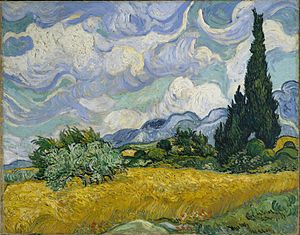Wheat Field with Cypresses
| A Wheatfield with Cypresses (New York) | |
|---|---|
 | |
| Artist | Vincent van Gogh |
| Year | July 1889 |
| Catalogue | |
| Medium | Oil on canvas |
| Dimensions | 73 cm × 93.4 cm (29 in × 36.8 in) |
| Location | Metropolitan Museum of Art, New York City |
| A Wheatfield with Cypresses (London) | |
|---|---|
 | |
| Artist | Vincent van Gogh |
| Year | September 1889 |
| Catalogue | |
| Medium | Oil on canvas |
| Dimensions | 72.1 cm × 90.9 cm (28.4 in × 35.8 in) |
| Location | National Gallery, London |
| A Wheatfield with Cypresses (Smaller Version) | |
|---|---|
 | |
| Artist | Vincent van Gogh |
| Year | September 1889 |
| Catalogue | |
| Medium | Oil on canvas |
| Dimensions | 51.5 cm × 65 cm (20.3 in × 26 in) |
| Owner | Private Collection |
A Wheatfield with Cypresses is any of three similar 1889 oil paintings by
Description
The painting depicts golden fields of ripe wheat, a dark fastigiate
Van Gogh had to take time off painting in order to deal with some severe problems due to mental illness in late July and early August, but was able to resume painting in late August and early September 1889. After making a
Vincent sent the larger July and September versions to his brother in Paris later in September 1889. The July version was sold by Theo's widow in 1900 to artist
The National Gallery in London holds a similar version painted in Van Gogh's studio in September 1889, bought with the Courtauld Fund in 1923. It is unlined, and was never varnished or waxed.
The third smaller version is held by a private collection (sold at Sotheby's in London in 1970; in the US in 1987).
-
Reed-pen drawing, held by the Van Gogh Museum in Amsterdam (F1538)
See also
Footnotes
- ^ Vincent Van Gogh's A Cornfield, with Cypresses, John Leighton, Anthony Reeve, Ashok Roy and Raymond White, National Gallery Technical Bulletin, 1987, Volume 11, pp 42–59.
- ^ Vincent van Gogh, A Wheatfield with Cypresses, illustrated pigment analysis at ColourLex
References
- National Gallery entry
- Metropolitan Museum of Art entry
- Vincent Van Gogh's A Cornfield, with Cypresses, John Leighton, Anthony Reeve, Ashok Roy and Raymond White, National Gallery Technical Bulletin, 1987, Volume 11, pp 42–59.
- Annenberg Donates A van Gogh to the Met, New York Times, 25 May 1993

